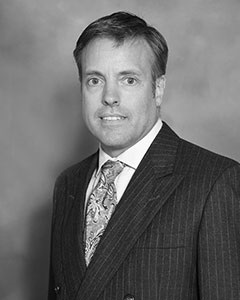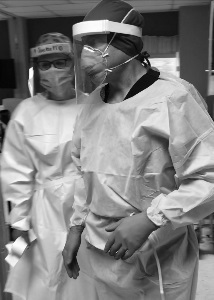In this issue, we talked to Daniel Ryan, MD, FAAPMR at Ascension Macomb-Oakland Hospital in Warren, MI. During the initial outbreak, Dr. Ryan worked as the President of Medical Staff for Physical Medicine and Rehabilitation and was charged with the responsibility of planning for if their hospital ended up succumbing to over-crowding due to the pandemic. In this role and working on the frontlines with other disciplines gave him a unique perspective to reflect on at the end of the initial surge. The following article is based on his experience as of mid-October 2020.
 Daniel Ryan, MD, FAAPMR
Daniel Ryan, MD, FAAPMR
Chief Medical Director
Center for Physical Medicine and Rehabilitation
Ascension Macomb-Oakland Hospital
When the coronavirus broke out, we were initially thrown off, as everyone was. We didn't really know what we were dealing with. Everyone was watching the media and seeing cases increase at Ascension Macomb-Oakland and around the area. As President of the Medical Staff, I was involved in helping figure out what we were going to do if the numbers reached a point where the hospital was over-capacitated, and we would need to bring additional beds into our area. What kept being our focus was "where's rehab's role involved in this?"
In relation to the pandemic, things changed based on what we knew at the time, and we just had to go with the flow. From a rehab standpoint, that's what we rehab doctors do. Everybody's different and it's still, in my view, what's real practicing medicine. In other areas, you have a recipe for this infection or this stroke or this heart disease. This is what you do for rehab — each person's different. You kind of just got to do what works, what helps somebody get better, what helps somebody get better walking. You do what you got to do.
Now that numbers have dwindled, I can say that I've learned some things clinically that I'll be looking back at and taking with me moving forward.
Typical Treatments
Most of our patients, at the beginning, were on ventilators. To answer our earlier question, we started to do bedside therapy. We realized that moving the patient from prone to supine position to help with lung capacity and getting rid of the number of fluids within the lungs seemed to be a big factor in terms of someone's outcome and coming off the vent.
That ended up being one of the more surprising things for me. We always knew that early mobility helped functional outcome. We always say, "Well, we're going to reduce risk for pressure sores, reduce risk for DVTs, reduce contractures," so you need early mobility. But I was taken aback by how much better they improved in their lung ability. That was what the problem was with the coronavirus that it caused such an inflammatory response and became such a compromise of their pulmonary capacity. I could see how beneficial early movement was to getting people weaned.
Post-rehab or post-infection, I think there's not been any significant difference than what we typically see in a lot of the other chronic issues and conditions that PM&R treats. Our typical treatments (what we use for people who have myopathy or myositis or disability from other chronic conditions) make us uniquely equipped to handle these types of emergencies from the get-go.
Multi-Disciplinary
When it comes to that recovery piece, physiatrists see these types of issues more than anybody else, even on an outpatient basis. Another physician might see a patient and be able to diagnose them, but their preparedness stops there. They don't do anything else by their training, whereas we see things and we think, "Okay, what can we do to help this person become functional? How can we make them improve in terms of their symptoms of pain or weakness?"
For example, if we have someone coming in for a neuropathy, we have modalities that we can use in therapy: we use electrical stem, various medications, bracing, etc. So, the Parkinson's, the strokes, the myopathy, the neuropathies, the muscular dystrophies, the multiple sclerosis, all these chronic syndromes we deal with all the time anyway. That's what we were seeing with the coronavirus.
You see a lot of people end up with myopathy. Well, that's what PM&R treats. The rehab physician is the one that is in charge of function and that's where we're at — we're at the point where they're rehabilitating. So, of course, that remains it should be the PM&R doctor who is spearheading the issue, leading the charge in helping people get better and improve. The pulmonary doctor isn't going to have a whole lot more to offer at this stage, for example, other than certain medications; the cardiologist is going to keep treating their individual area. The all-encompassing part of treating patients now comes down to the physicians who are multi-disciplinary. That's what rehab doctors do.
Early and Across the Care Continuum
Post-COVID-19, other disciplines in the hospital realize the importance of rehab more than they did ever before. Obviously, pre-pandemic you would have a cardiologist or neurologist say, "Transfer to inpatient rehab" or "get rehab involved," not really knowing what all rehab encompasses or the full benefit. "It's going to get them stronger and get them walking," they might say. 
You'd get the intensivist in the early issues in the ICU, the patient would go to the general medical floor or multiple settings before eventually, maybe, ending up in inpatient rehabilitation. It might be a week or 10 days after a long stay in the hospital where, at the end of the treatment, all of a sudden their other physician goes, "Oh, this patient's weak and debilitated. Get rehab involved."
In this case, we were on the frontlines just like everybody else. There was the ICU doctor, the intensivist and the physiatrist working next to each other, seeing a patient. Our peers from other specialties were able to see the benefit in including physiatry early in the care continuum and that rehab's early involvement made a significant difference in the medical outcome.
Continuous Learning
As I mentioned, this was a situation no one was prepared for. In this, it highlighted the importance of continuous learning and even re-learning. With our patients that were so debilitated from their time on the ventilators and their positioning, there were times I needed to relook at what the proper way to position a person was without causing additional problems, especially given they were on vents and/or had multiple lines in them. I had to return to how to do the postural positioning to help with lung capacity.
In the beginning, too, I tried to keep up on anything that was new regarding the coronavirus, and there's a lot of stuff out there! I was getting emails all the time, AAPM&R was putting out webinars and resources, etc. I did get information, too, from other areas world-wide even that had experienced COVID-19 because they were basically a month or two ahead of the United States. It was up to me to educate myself in terms of how people were functioning throughout the different phases, what other physiatrists were doing and other processes to implement.
Moving Forward in Physiatry
I think that as we move forward, this pandemic kind of reset everything. You can get kind of bogged down. And I think every once in a while you need a reboot. This has done a reboot for all of us, but particularly for our discipline.
I think the whole experience made everyone remember what they're in it for. You're treating the patient, that's what you're trying to do. They're people, they're sick, they're relying on you. You're doing the best you can. You don't know everything, but you're there for them.